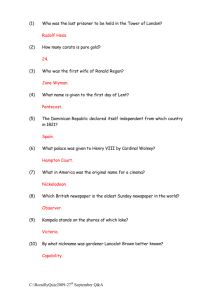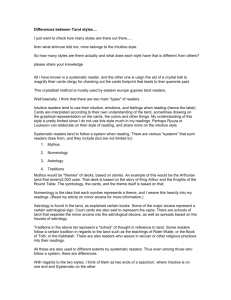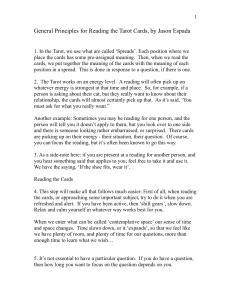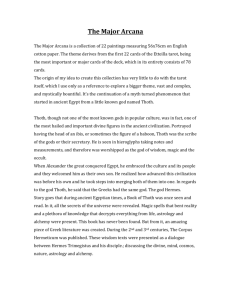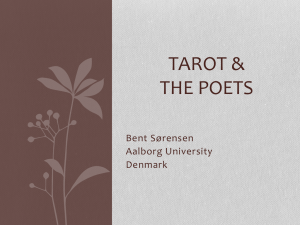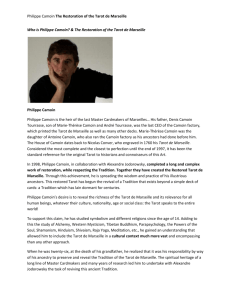SPEECH #1 – INFORMATIVE SPEECH Name: LAURA CROFT Title
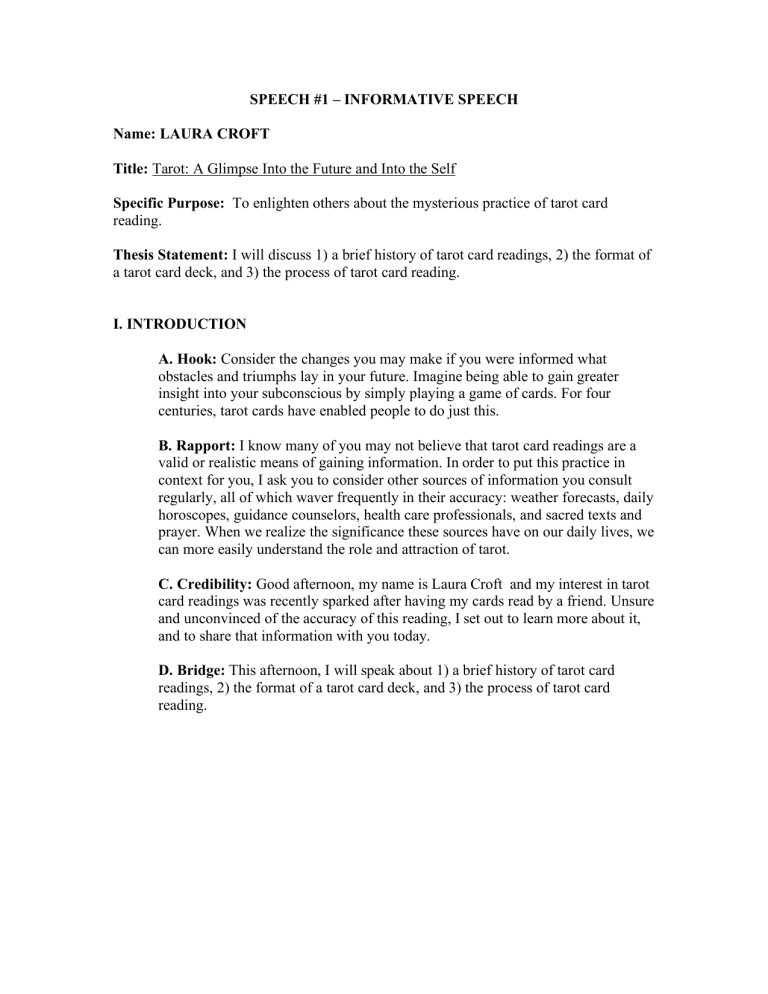
SPEECH #1 – INFORMATIVE SPEECH
Name: LAURA CROFT
Title: Tarot: A Glimpse Into the Future and Into the Self
Specific Purpose: To enlighten others about the mysterious practice of tarot card reading.
Thesis Statement: I will discuss 1) a brief history of tarot card readings, 2) the format of a tarot card deck, and 3) the process of tarot card reading.
I. INTRODUCTION
A. Hook: Consider the changes you may make if you were informed what obstacles and triumphs lay in your future. Imagine being able to gain greater insight into your subconscious by simply playing a game of cards. For four centuries, tarot cards have enabled people to do just this.
B. Rapport: I know many of you may not believe that tarot card readings are a valid or realistic means of gaining information. In order to put this practice in context for you, I ask you to consider other sources of information you consult regularly, all of which waver frequently in their accuracy: weather forecasts, daily horoscopes, guidance counselors, health care professionals, and sacred texts and prayer. When we realize the significance these sources have on our daily lives, we can more easily understand the role and attraction of tarot.
C. Credibility: Good afternoon, my name is Laura Croft and my interest in tarot card readings was recently sparked after having my cards read by a friend. Unsure and unconvinced of the accuracy of this reading, I set out to learn more about it, and to share that information with you today.
D. Bridge: This afternoon, I will speak about 1) a brief history of tarot card readings, 2) the format of a tarot card deck, and 3) the process of tarot card reading.
II. BODY
A.
What Are the Origins of Tarot?
1.
Origin i.
Time period and place (Encyclopedia Britannica, Tarot ) ii.
Use in early society (Place, Robert, The Tarot )
2.
Development i.
Standardization ii.
Fortune Telling
Transition Statement: Now that I have given a short history and description of tarot cards, I will explain the format of a deck of tarot cards.
B.
Format of Tarot Cards
1.
Aspects of a deck i.
Number of cards ii.
Numbers ad royal cards
2.
Different suits i.
Associations with four suits (Lenard, Lisa, and Arlene
Tognetti, Complete Idiot’s Guide ) ii.
Significance of fifth suit
Transition Statement: A solid understanding of the format of tarot cards is necessary in order to understand the process of a tarot card reading.
C.
Reading Tarot Cards
1.
Reading your own deck i.
Preparation (Sharman-Burke, Juliet, The New Complete
Book of Tarot ) ii.
Energy (MacGregor, Trish, and Phyllis Vega, Power Tarot )
2.
Having your cards read by a reader i.
Positive connection (Lenard, Lisa, and Arlene Tognetti,
Complete Idiot’s Guide ) ii.
Querent (definition)
3.
The reading process i.
Asking a question (Lenard, Lisa, and Arlene Tognetti,
Complete Idiot’s Guide ) ii.
Spread iii.
Symbolism iv.
Reversed cards (Lenard, Lisa, and Arlene Tognetti,
Complete Idiot’s Guide )
III. CONCLUSION
In conclusion, tarot card readings have been practiced for over four centuries, intriguing participants with its mysterious symbolism. Many believe that tarot card reading is either an inaccurate and superstitious or a just plain frightening way of predicting the future.
Although I am not asking you to change your opinion or lifestyle, my research showed me that this practice is not actually focused on deciding the future, but rather on gaining insight into one’s subconscious mind. Trying to associate aspects of one’s life with the symbols of the cards challenges the Querent to consider their temperament and people and events in his or her life, in a fresh light. Acquiring a new perspective may even inspire a healthier outlook, attitude, or relationship with others. Just like you use weather.com to predict the weather or counselors to give you advice, tarot card readings can give you helpful hints that can help you make important decisions about your future.
IV. BIBLIOGRAPHY
1. “Tarot.” Encyclopedia Britannica. 2010. Encyclopedia Britannica Online. 01 May
2010. < http://www.britannica.com/EBchecked/topic/583645/tarot>.
Paraphrase: Tarot cards were created in 15 th century Northern Italy, when a fifth suit was added to the regular card deck.
2. Place, Robert M. The Tarot: History, Symbolism, and Divination. New York: Penguin
Books Ltd., 2005. Pg 5
Quote: “This fifth suit is now called ‘trump cards’ because originally it was used to trump the other cards in an early form of bridge” (2).
3. Lenard, Lisa, and Arlene Tognetti. The Complete Idiot’s Guide to Tarot .
. New York:
Penguin Books Ltd., 2003. Pg 5,6,7
Paraphrase: Cards of the wand suit are symbolic of action and labor; cups symbolize emotion, swords power and obstacles, and pentacles – this star figure – possessions and material wealth (94).
Paraphrase: Lenard and Tognetti of The Complete Guide to Tarot emphasize, and I’m paraphrasing, how important it is that you feel a positive connection with your reader
(15).
Paraphrase: Lenard and Tognetti elaborate that this question can either be very specific, like “When will I meet my soulmate?” or more broad like, “What is going to happen in the world this year?” (16).
Quote: “ Each card relates to the Querent’s question depending on its position in the
Celtic Cross spread” (167).
Quote: “Reversed cards occur when lessons on the card are challenging for the Querent”
(32).
4. Sharman-Burke, Juliet. The New Complete Book of Tarot. New York: St. Martin’s
Press, 2007. Pg 5
Quote: “Get to know your tarot deck…the most important thing is that you feel at home with your cards” (28).
5. MacGregor, Trish, and Phyillis Vega. Power Tarot. New York: Simon & Shuster Inc.,
1998. Pg 5
Quote: “Try sleeping with your cards under your pillow to infuse them with energy”
(16).
